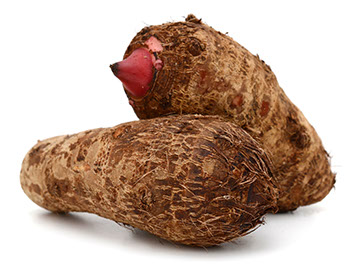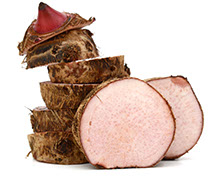Overview
Characteristics
Nutrition Information
Malanga Lila
It was first cultivated in tropical America, and spread to Africa in the mid 1800s, and is also grown in the Philippines. They are especially popular in Cuba (malanga) and Puerto Rico (yautia). Malanga lila has more flavor than most other starchy tropical tubers, and its taste is earthy, and has been described as more like nuts than potatoes.
Sources: USDA.gov/AMS


Tropical American aroid, which has edible tubers that are cooked or eaten like yams or potatoes.This plant is related to Taro and is extensively cultivated in the West Indies and other tropical countries for the edible cormandcormels. On certain varieties the young leaves and main stems (madre) are also used as pot herbs. The leaves are large, 1 to 2 feet long, broad arrow in shape, borne on long petioles radiating from the “mother” or large corm.
Sources: The Proudce Blue Book
Nutrition Facts
Serving Size 2/3 cup (85g)
Amount Per Serving
Calories from Fat 0Calories 90
% Daily Values*
Total Fat 0g 0%
Saturated Fat 0g 0%
Cholesterol 0mg 0%
Sodium 10mg 0%
Total Carbohydrate 23g 8%
Dietary Fiber 2g 8%
Sugars 0g
Protein 1g
Vitamin A 0% Vitamin C 6%
Calcium 6% Iron 2%
* Percent Daily Values are based on a 2000 calorie diet. Your daily values may be higher or lower depending on your calorie needs.


Century Farms International, Inc.
10957 NW 123rd Street Medley, FL 33178
Office: 305-436-7971 Fax: 305-436-7968



